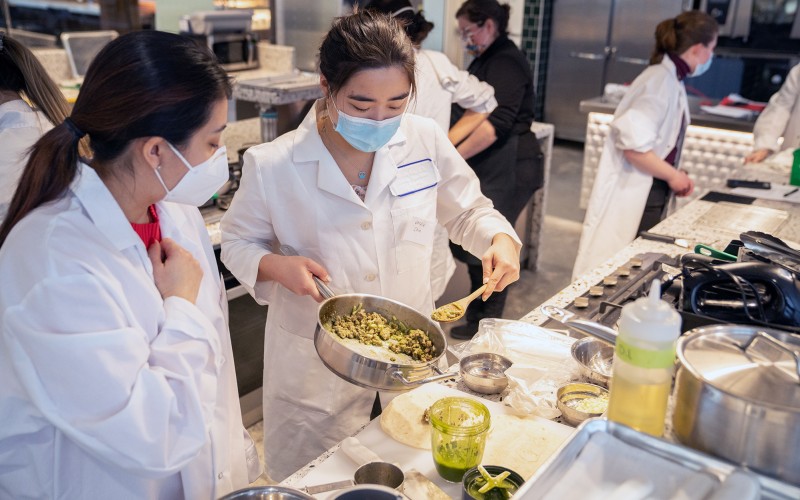Primary tabs

Students prepare a recipe in the course Food for Contemporary Living, taught in the new Discovery Kitchen in Toni Morrison Hall. Photo: Darcy Rose/Provided.
In February, students in the two-credit course NS2470: Food For Contemporary Living gathered for the first time in the Discovery Kitchen, a state-of-the-art teaching space built into the ground floor of Toni Morrison Hall on North Campus.
A joint project of the College of Human Ecology and College of Agriculture and Life Sciences’ Division of Nutritional Sciences and Cornell Dining, the space functions as a classroom, event space, and test kitchen. “Students get to see equipment they might not see otherwise — an industrial grill, pasta machine, fancy pizza ovens,” says lecturer Erin Green, Ph.D., RD, who teaches the course and directs the Didactic Program in Dietetics. “It’s a cool experience — they’re immersed in Cornell Dining and not just in a classroom.”
Food For Contemporary Living is one of the first courses to use the Discovery Kitchen, which represents an upgrade from the previous teaching kitchen in Martha Van Rensselaer Hall. Students pass through Morrison Dining to reach the 2,400-square-foot glass-and stainless-steel facility. Meanwhile, patrons in the 1,000-seat dining room, which opened in January 2022, have a clear view of activities inside, whether students immersed in classes or Cornell Dining chefs developing new menu items.

Lecturer Erin Green (left) and lab manager Mandy Bates (center) work with a student in the kitchen. Photo: Darcy Rose/Provided
A required course for all dietetics students and a popular elective across campus, Food for Contemporary Living integrates an overview of ingredients and food preparation techniques with principles of nutrition and health promotion. Three sections accommodate as many as 75 students and there’s usually a waiting list. In addition to Human Ecology students, the spring 2022 cohort includes students from engineering, art history and food science.
Each three-hour session explores a theme — from menu planning to lighter desserts. Ceiling-mounted monitors and a sound system give every student the ability to watch Green’s lecture, as well as their peers’ presentations on cultural food variations. Then each student tackles a recipe.
“There might be more than one student making homemade pasta, but each is responsible for a dish from beginning to end,” says Green, who welcomes novices and amateurs alike. “Maybe they’ve never made pasta or even boiled water, and they learn how to make a lot of different foods in just one semester.”
Students share workstations with a dedicated convection oven, five-burner gas range, undercounter refrigerator, sink, and two-tiered counter. Green credits the layout with helping her to teach personal and food safety, while boosting confidence among students who may be unfamiliar with how to start a gas oven or handle a chef’s knife.
Each student completes a sensory evaluation of their recipe each week— including a taste test — and the class debriefs on the week’s theme and attempted recipe modifications. For their capstone project, each plans a full day’s menu tailored to their individualized nutritional requirements and prepares their dinner in class. (Green requires that the menu plan adhere to the daily budget of the USDA Thrifty Food Plan, which is the basis for the federal Supplemental Nutrition Assistance Program.)
Green says she’s been delighted to see a strong camaraderie emerge among her students. Many share family recipes or personal experiences in their presentations on food traditions associated with the weekly theme. Vietnamese Banh Mi sandwiches featured in one student’s talk for the lab on yeast breads, while another reflected on foodways of the Southern U.S. as she described her family’s traditional biscuits for the quick breads lab. Students also find ways to collaborate — helping a neighbor roll pasta while they wait for a pot of water to boil or offering feedback on the look or aroma of a finished dish. “It’s great seeing them cook together,” says Green. “There’s definitely a sense of excitement and enthusiasm.”
Back to Human Ecology magazine